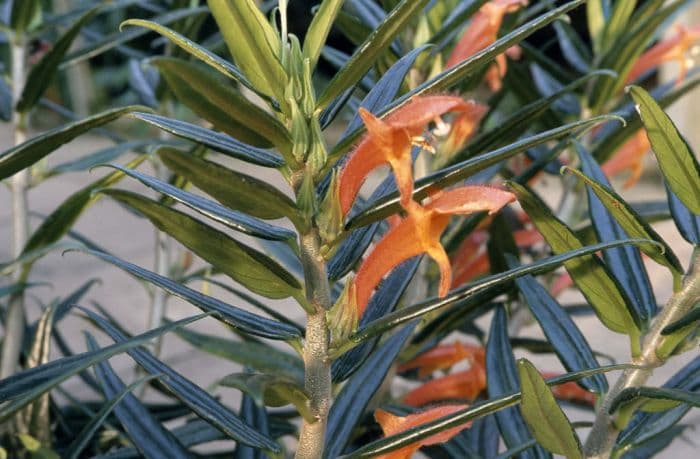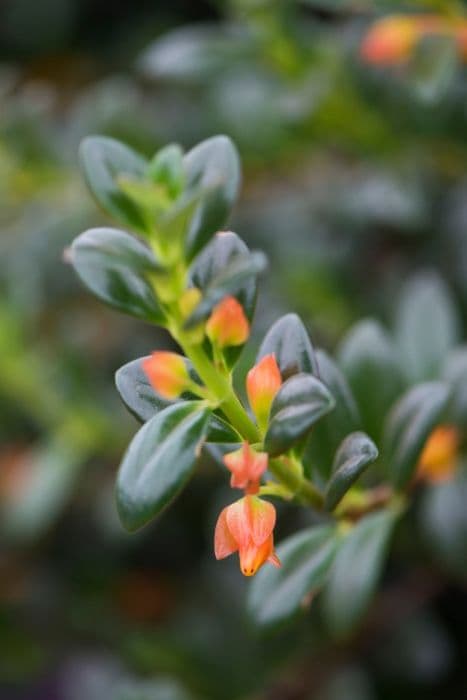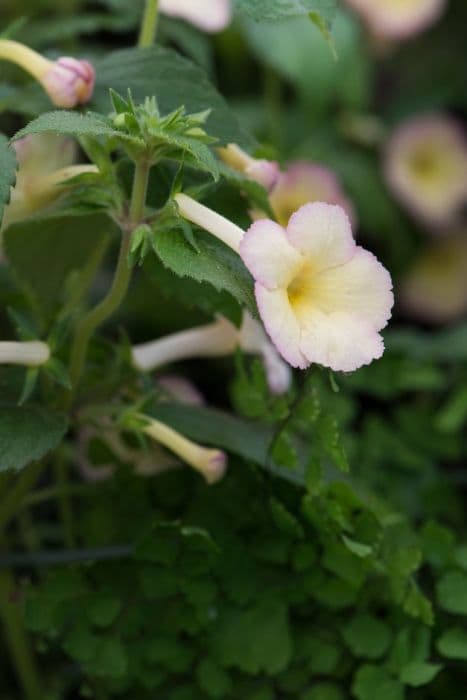Lipstick Plant Aeschynanthus longicaulis

ABOUT
Known commonly as the Lipstick Plant, Aeschynanthus longicaulis is an attractive evergreen perennial that boasts a trailing or vine-like growth habit, making it an excellent choice for hanging baskets or as a climbing plant with a little support. What makes this plant particularly striking are its vividly colored flowers that emerge from darker, tube-like structures reminiscent of a lipstick tube, hence its name. The leaves of the Lipstick Plant are glossy, thick, and often have a leathery texture, with an elongated, pointed shape and a dark green color that contrasts sharply with the bright blooms. These flowers typically appear at the ends of the branches, bursting forth in a showy display of reds, oranges, or occasionally yellows. The blooms can be quite profuse when the plant is well cared for, covering the trailing stems in a cascade of color. This tropical plant's flowers offer a bold aesthetic, with a funnel-shaped, flamboyant flair that can add a touch of the exotic to any interior décor. Despite its showy appearance, the Lipstick Plant is not only prized for its flowers but also for its attractive foliage which remains beautiful throughout the year, even when the plant is not in bloom. The combination of its luscious flowers and lush leaves makes this plant a popular choice for adding a splash of vibrant life to indoor spaces.
About this plant
 Names
NamesFamily
Gesneriaceae
Synonyms
Black Pagoda, Lipstick Vine
Common names
Aeschynanthus longicaulis.
 Toxicity
ToxicityTo humans
Lipstick plant (Aeschynanthus longicaulis) is not known to be toxic to humans. Therefore, there are no specific symptoms associated with poisoning from ingesting this plant, as it is generally considered non-toxic. Ingesting any part of this plant is unlikely to result in adverse health consequences. However, it is always advised to keep all plants out of the reach of small children who might accidentally ingest plant matter.
To pets
Lipstick plant (Aeschynanthus longicaulis), like to humans, is also typically non-toxic to pets. This includes cats and dogs. There should be no symptoms of poisoning from pets ingesting this plant, as it is considered pet-safe by the ASPCA (American Society for the Prevention of Cruelty to Animals). Consequently, ingesting parts of the lipstick plant should not result in any toxic consequences for pets. However, it's still a good practice to monitor pets around plants to prevent any potential digestive upset caused by eating non-food items.
 Characteristics
CharacteristicsLife cycle
Perennials
Foliage type
Evergreen
Color of leaves
Green
Flower color
Red
Height
1-2 feet (30-60 cm)
Spread
1-2 feet (30-60 cm)
Plant type
Climber
Hardiness zones
10
Native area
Southeast Asia
Benefits
 General Benefits
General Benefits- Ornamental Appeal – Aeschynanthus longicaulis, commonly known as the Lipstick Plant, has attractive foliage and flamboyant flowers, making it a popular decorative houseplant.
- Low Maintenance – The Lipstick Plant requires minimal care beyond regular watering and occasional feeding, making it suitable for those with busy lifestyles or novice gardeners.
- Humidity Tolerant – This plant thrives in high humidity environments, which makes it ideal for bathrooms or kitchens where other plants might struggle.
- Positive Psychological Effect – Like many houseplants, it can contribute to a reduction in stress levels and an improvement in mood for those who interact with it.
 Medical Properties
Medical PropertiesThis plant is not used for medical purposes.
 Air-purifying Qualities
Air-purifying QualitiesThis plant is not specifically known for air purifying qualities.
 Other Uses
Other Uses- Artistic Inspiration: Aeschynanthus longicaulis, commonly known as Lipstick Plant, can serve as an artistic muse due to its vividly colored blooms and unique trailing growth, inspiring artists and photographers alike.
- Humidity Indicator: The Lipstick Plant prefers high humidity environments, so it can be used as a natural indicator of the humidity level in a room, requiring more attentive care when the leaves begin to dry out.
- Educational Tool: Gardening enthusiasts and educators can use the Lipstick Plant to teach principles of botany and horticulture, such as propagation techniques and tropical plant care.
- Biomimicry Studies: The unique morphology of the Lipstick Plant's flowers can inspire designs in the field of biomimicry, where nature's patterns and strategies are emulated in man-made materials and structures.
- Feng Shui: According to Feng Shui, placing a Lipstick Plant in the home can bring positive energy, as its lush greenery and cascading form are thought to promote growth and flow in life.
- Photography Subject: Due to its striking appearance, the Lipstick Plant can be featured as a subject in macro and still life photography, highlighting the intricate details of its flowers and leaves.
- Container Gardening: Aeschynanthus longicaulis is well-suited for growing in hanging baskets and containers, ideal for urban gardeners with limited space to add a tropical flair to balconies and small patios.
- Craft Projects: The plant's long, pliable stems and colorful blooms can be used in living craft projects, such as living wreaths or table centerpieces.
- Gift Giving: A potted Lipstick Plant makes for a unique and thoughtful gift, especially for those who appreciate exotic plants that are relatively easy to maintain.
- Interior Design: The Lipstick Plant can be used by interior designers to add a pop of color and living art to home decor, especially in modern and minimalist settings where the plant's vibrant hues can stand out.
Interesting Facts
 Feng Shui
Feng ShuiThe Lipstick Plant is not used in Feng Shui practice.
 Zodiac Sign Compitability
Zodiac Sign CompitabilityThe Lipstick Plant is not used in astrology practice.
 Plant Symbolism
Plant Symbolism- Enthusiasm and Happiness: The bright colors and vibrant growth habit of the Aeschynanthus longicaulis, commonly known as the Lipstick Plant, are often associated with joy and cheerfulness.
- Resilience: The Lipstick Plant is known for its hardiness and its ability to thrive in various conditions, symbolizing resilience and adaptability in life.
- Hospitality: With its welcoming appearance, often used to decorate homes, the Lipstick Plant symbolizes hospitality and warmth in welcoming guests.
 Water
WaterLipstick plants (Aeschynanthus longicaulis) prefer evenly moist soil, so it's important to water them when the top inch of soil feels dry to the touch. Generally, this will be about once a week, but the frequency may increase in warmer temperatures or if the plant is in a particularly sunny spot. It's best to use room temperature water and to water the plant thoroughly until excess water drains out of the bottom, indicating that the soil is saturated. Depending on the size of the pot, this might be between 8 to 16 ounces of water each time. Pay close attention to ensure that the soil is not soggy as this can lead to root rot.
 Light
LightLipstick plants thrive in bright, indirect light. A spot near an east or west-facing window where they can receive gentle morning or evening sunlight would be ideal. Avoid placing them in direct afternoon sun, which can scorch their leaves, but also avoid deep shade, which could stifle their blooming. Ensuring adequate light will support their growth and vibrant flower production.
 Temperature
TemperatureThe ideal temperature for lipstick plants is between 65 and 80 degrees Fahrenheit. They can tolerate a minimum temperature no lower than 50 degrees Fahrenheit and should not be exposed to temperatures over 90 degrees Fahrenheit as extreme temperatures can stress the plant. Ensure that the plant is kept away from drafts and sudden temperature changes for optimal growth.
 Pruning
PruningPrune lipstick plants to maintain their shape and encourage bushier growth. The best time for pruning is in the spring, just before the growth season begins. Lightly trim back leggy stems, and remove any yellow or dead leaves to improve the plant's overall health and appearance. Pruning can be done as needed throughout the year to remove any unwanted growth or to control the size of the plant.
 Cleaning
CleaningAs needed
 Soil
SoilThe Lipstick Plant thrives in a well-draining, peat-based potting mix with added perlite or vermiculite. Aim for a soil pH between 6.0 and 7.5 to ensure optimal growth.
 Repotting
RepottingLipstick Plants should be repotted every two to three years to refresh the soil and encourage continuous growth.
 Humidity & Misting
Humidity & MistingLipstick Plants prefer high humidity levels, ideally between 60% to 80%, to mimic their native tropical environment.
 Suitable locations
Suitable locationsIndoor
Bright, indirect light and high humidity suit Lipstick Plants indoors.
Outdoor
Place Lipstick Plant in shaded area; protect from direct sun.
Hardiness zone
10-12 USDA
 Life cycle
Life cycleAeschynanthus longicaulis, commonly known as Lipstick Plant, begins its life cycle with seed germination, where the seeds will sprout when exposed to warm temperatures and consistent moisture. After germination, the seedling stage follows, involving initial leaf development and root establishment. Progressing to the vegetative stage, the plant experiences robust leaf and stem growth, often characterized by its trailing or vining habit, with bright green leaves emerging along the stems. The Lipstick Plant then enters the flowering stage when it matures; it produces tubular red or orange flowers, which resemble a lipstick tube, mainly during the summer months. After successful pollination, typically by hummingbirds or insects, the flowers develop into small capsules containing seeds. The cycle potentially repeats if the seeds are dispersed and find suitable conditions for germination, closing the loop of the life cycle.
 Propogation
PropogationPropogation time
Spring-Early Summer
Propogation: The Aeschynanthus longicaulis, commonly known as the 'Lipstick Plant', can be easily propagated through stem cuttings. The ideal time for propagation is during the spring or early summer when the plant is actively growing. To propagate using stem cuttings, select a healthy portion of the stem that has at least two to three sets of leaves. Cut the stem just below a leaf node, about 4 to 6 inches (10-15 cm) in length. Remove the leaves from the lower half of the cutting to prevent decay and to encourage root growth. Dip the cut end in rooting hormone powder to enhance root development. Insert the cutting into a well-draining potting mix and ensure the soil remains moist but not overly wet. Place the pot in a warm, brightly lit area, avoiding direct sunlight, which can scorch the tender cuttings. Roots generally begin to form within a few weeks, after which the new Lipstick Plant can be transplanted to a permanent container.









